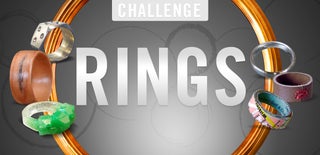Introduction: Woven Wire Rings
I'd been eyeing this tutorial of a simple wire ring for a while, but I was unwilling to pay for something I thought I could figure out myself (No offense to the artist! I just like to test my intelligence from time to time.). Eventually, I got around to trying it out over my winter break (whilst watching The Legend of Korra...) and discovered the fun in weaving for aesthetic design rather than to add strength by binding wires. Figuring out the patten for that inspiring ring spurred me to try inventing my own designs, and the rest of the story is told within the steps of this tutorial.
Step 1: Inspiration
The pictures above are images of my first attempt at recreating the ring I referred to in the intro. I'd love to share a tutorial for it with you (such a gorgeous design!) but this design is for sale by its original creator. If you do want to learn how to make this design, I suggest you non-cheap-and-broke-college-students support the author and purchase the tutorial complete with what will probably be far more descriptive instructions than what I can provide.
Step 2: Materials
- wire (I mixed and matched different colors and gauges. Colors: rose gold, black, gunmetal. Gauges: 20, 24, and 26 gauges.)
- pliers
- paper and pen to draw designs
Step 3: Introductory Breakdown
For the base wires that will be woven around, I cut out 20 gauge wire around 3" long. I left a bit excess so that I could curl the wire ends (rather than allowing them to poke holes on the inside of my hand..). For those with soldering equipment though, soldering the ends would work perfectly.
For the thin weaving wire, I cut out about 1.5' of 24 or 26 gauge wire. This length is a generalization only, as the length really depends on how long your ring band is, how much weaving will be done, etc.
For ending the ring, you can see four ways in the above picture. The first one just involves wrapping a lot of thin wire to hide the ends -- the best method I liked for ending rings with 5 or more strands (because loops would take too much space).The next three just consist of curling the ends into loops, and the arrangement of those loops determines whether your result will look like the second, third, or fourth design.
~~~~~~~~~~~~~~ Let's get down to business, shall we?
The ensuing steps will guide you through how to recreate the designs I came up with (ordered in terms of relative difficulty), and instead of instructions in paragraph form I typed them up as notes for each accompanying picture to make step-by-step instructions.
A last note: it's a good idea to practice a bit with weaving wire and searching up tutorials on google for basic wire working if you're new to this. It can be difficult to understand at first. Also, trying out designs using chopsticks and yarn is a great way to test out your design or skill before committing to using wire.
Step 4: Disconnected Stripes
Main concept: discontinuity (creating unconnected units by repeatedly beginning and ending a design)
Basic guide to my shorthand lingo:
- 1, 2, 3, etc. = these numbers (unless referring to a number of wraps or something) refer to the thick base wires counting from the top
- (u) = underhand wrapping; this means that you wrap the thin wire behind a thick base wire up and around.
- (o) = overhand wrapping; this means that you wrap the thin wire behind a thick base wire down and around.
Step 5: Double Stripes
Main concept: starting with two wires (starting at two locations and alternating them to create a design)
Basic guide to my shorthand lingo:
- 1, 2, 3, etc. = these numbers (unless referring to a number of wraps or something) refer to the thick base wires counting from the top
- (u) = underhand wrapping; this means that you wrap the thin wire behind a thick base wire up and around.
- (o) = overhand wrapping; this means that you wrap the thin wire behind a thick base wire down and around.
Step 6: Diamond
Main concepts: starting at the middle AND criss-cross (winding the middle of your thin wire around the middle base wire AND crossing your wires so that you don't end up with a tangle)
Basic guide to my shorthand lingo:
- 1, 2, 3, etc. = these numbers (unless referring to a number of wraps or something) refer to the thick base wires counting from the top
- (u) = underhand wrapping; this means that you wrap the thin wire behind a thick base wire up and around.
- (o) = overhand wrapping; this means that you wrap the thin wire behind a thick base wire down and around.
Step 7: Triple Threat
Main concept: crosses (inserting wire into a gap to create crosses)
Basic guide to my shorthand lingo:
- 1, 2, 3, etc. = these numbers (unless referring to a number of wraps or something) refer to the thick base wires counting from the top
- (u) = underhand wrapping; this means that you wrap the thin wire behind a thick base wire up and around.
- (o) = overhand wrapping; this means that you wrap the thin wire behind a thick base wire down and around.
Step 8: Have Fun
Of course, have fun weaving wire for you or your loved ones. Mix and match my designs' concepts to create your own rings -- give your creativity free-rein to design the perfect ring for your unique self. I hope you've enjoyed this tutorial; if anything is unclear for you, feel free to drop a comment explaining which step, and I'll do my best to clear your confusion.

First Prize in the
Rings Challenge











